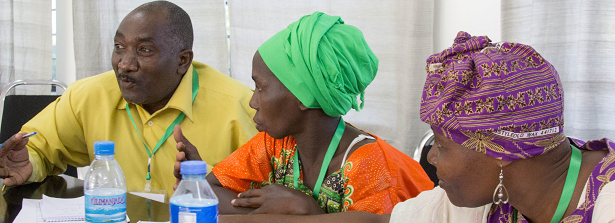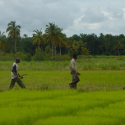Highlights from Learning Platform on investments in Tanzania

On April 27 and 28, 2017, a first multi-stakeholder Learning Platform on Land Governance and Food Security was organized in Ifakara, Tanzania1. The Learning Platform creates space for dialogue and learning around land-based investments in agriculture and forestry in the Kilombero Valley in Tanzania.
The main question addressed during the two-day meeting was how to better align land-based investments with local development priorities. Two central pillars of the multi-stakeholder approach in the Learning Platform are: 1) preparatory bottom-up research into local priorities and; 2) integration of a structure for follow-up and monitoring to support on the ground changes. This blogpost shares some highlights from this process and presents an agenda for action.
Kilombero Valley
The Kilombero Valley is generally seen as an investment hub with good climatic conditions and fertile soils, and hosts a number of large-scale land-based investments in agriculture and forestry. Three long-standing investments have been present in the area: the Kilombero Sugar Company (KSC) since 1962, Kilombero Plantations Limited (KPL) since 1986, and the Kilombero Valley Teak Company (KVTC) since 1992. The Valley has changed significantly since the arrival of these companies, who all have large plantations between 5,800 and 10,700 hectares and integrate thousands of smallholders in their business models. Next to direct company-attributed effects, the area faces amongst others effects of migration, climate change, and nature conservation.
The Learning Platform in April gathered a total of 23 participants, including representatives from the companies, local communities surrounding the investment areas, district government officials, civil society organizations and researchers working in the area.
Local priorities
The discussions were kicked-off with the findings of the local assessment in a number of selected villages around two of the main investments in the Kilombero Valley (KSC and KVTC). The goal of the assessment was to uncover some of the local expectations, development priorities, and aspirations of community members confronted with investments. This is also one of the distinguishing characteristics of the Learning Platform: whereas we have seen quite an increase in multi-stakeholder dialogues around land-based investments worldwide, the platform’s discussions were grounded in research findings from communities living around the investments.
This bottom-up research showed that companies increased residents’ income through employment and contributed to local development projects using established social funds. The local assessment also identified ways in which companies were seen as working against the community aspirations. For example, there was limited communication with communities regarding company activities in their villages and limited involvement of youth in the investments. Several of the challenges found were experienced in similar ways across the two investments. Other pressures faced by the communities were climate change, poor governance, and low education; it was discussed how these pressures had an impact on the relationship between the investors and local communities.
Facts and figures directly ‘from the ground’, including an insight in ‘broader local development priorities’, were received positively as a start for discussions in the Platform. Participants recognized that there are important gaps in expectations from different stakeholders: businesses are there to do business and expect government to contribute to an enabling environment to do that, meanwhile governments expect businesses to contribute to development, and local communities receive scattered and sometimes unreliable information regarding what they can expect from companies and the government.
Ways forward – an agenda for collaborative action in 2017
Four overarching priority challenges for follow-up activities were identified through collaborative group work: limited communication among investors and communities; limited transparency of the investors particularly in their contracts with communities; poor governance and accountability in some places; and restricted youth involvement. Companies in close coordination with community members, district government and civil society, identified a number of concrete activities that they are interested in working on in the coming weeks and months.
The platform showed a number of lessons in the use of multi-stakeholder approaches to making investments more inclusive and sustainable. First, the exchange of experiences between companies in different value chains – and how such exchange can contribute to adaptive learning of different stakeholders. Even though business models are quite different, in terms of their organisation and potential to be inclusive, companies did face similar challenges and appreciated an open platform to learn from each other’s experiences. It also showed the value of information coming straight from communities, and companies in particular appreciated the attendance of a number of individual community members, which led to increased understanding of local priorities – and how their business activities fit (or don’t fit) in those existing local ideas of development. The platform members came up with a number of very concrete ideas for improving development impact of investments, and are currently working on activities to increase transparency, improve communication and strengthen community involvement in the business models.
Early findings from the Kilombero Valley
- The value of and appreciation of bottom-up local research as departure point for multi-stakeholder dialogue
- The merits of taking a territorial/geographical approach, in facilitating exchange between a mix of different business models
- The importance of creating a continuous process around multi-stakeholder exchange, with follow-up support and collaborative monitoring.
The Learning Platform meeting is part of a continuous process throughout 2017, and the platform members will continue to meet in the remainder of the year, for support to follow-up activities and reflective monitoring. The first Learning Platform meeting in April was used to explore current challenges and developments, to set the agenda, and to identify topics for collaborative action. In the coming months, similar Learning Platforms will be organized in Mozambique and Uganda.
_ _ _
More information about the Learning Platform in Tanzania, or the upcoming Learning Platforms in Mozambique and Uganda can be found on the following websites:
www.landgovernance.org and www.sharedvaluefoundation.com
Footnotes
- 1. The Learning Platforms is a collaborative project between CIFOR, the Netherlands Land Academy (LANDac), the Food & Business Knowledge Platform (F&BKP), and Shared Value Foundation (SVF)







Hi there, thank you for sharing about this learning platform in Tanzania. What is special you got all stakeholders around the table.
I was triggered by the sentence “companies (…), who integrate thousands of smallholders in their business models”. What do these models look like, since further down the text it says there is increased income for residents but also scope to improve youth employment.
Hi Wim, Thanks for your comment and question! Regarding the type of business models: all models involved in the platform are hybrid models, combining plantations with smallholder production. The details of their set up are different, we have – on purpose – mixed companies from different value chains – so that they can also learn from each other.
The challenge with including youth in agriculture and forest-related business models, is that one of the main ways to include local stakeholders, is through outgrower arrangements. And this in turn requires access to land. Most young people do not (yet) have own access to land. This makes it more difficult for young people to engage in the business models as outgrowers. So yes, income overall may increase – but in general it is more difficult for young people to participate. In the Kilombero Valley, we also found that young people in the area were often less informed about the investments (partly as a response to their limited options to be involved as smallholder producers) – and did not know how to increase their direct or more indirect benefits from the investments.
As part of the follow-up trajectory, one of the participating companies has now started the initiative of organising lectures in primary and secondary schools in the area. To provide information about the benefits of tree growing, about sustainable forest management, and to explain more about what the company is doing in the area and how its operations are organised.
Hope this answers your question!